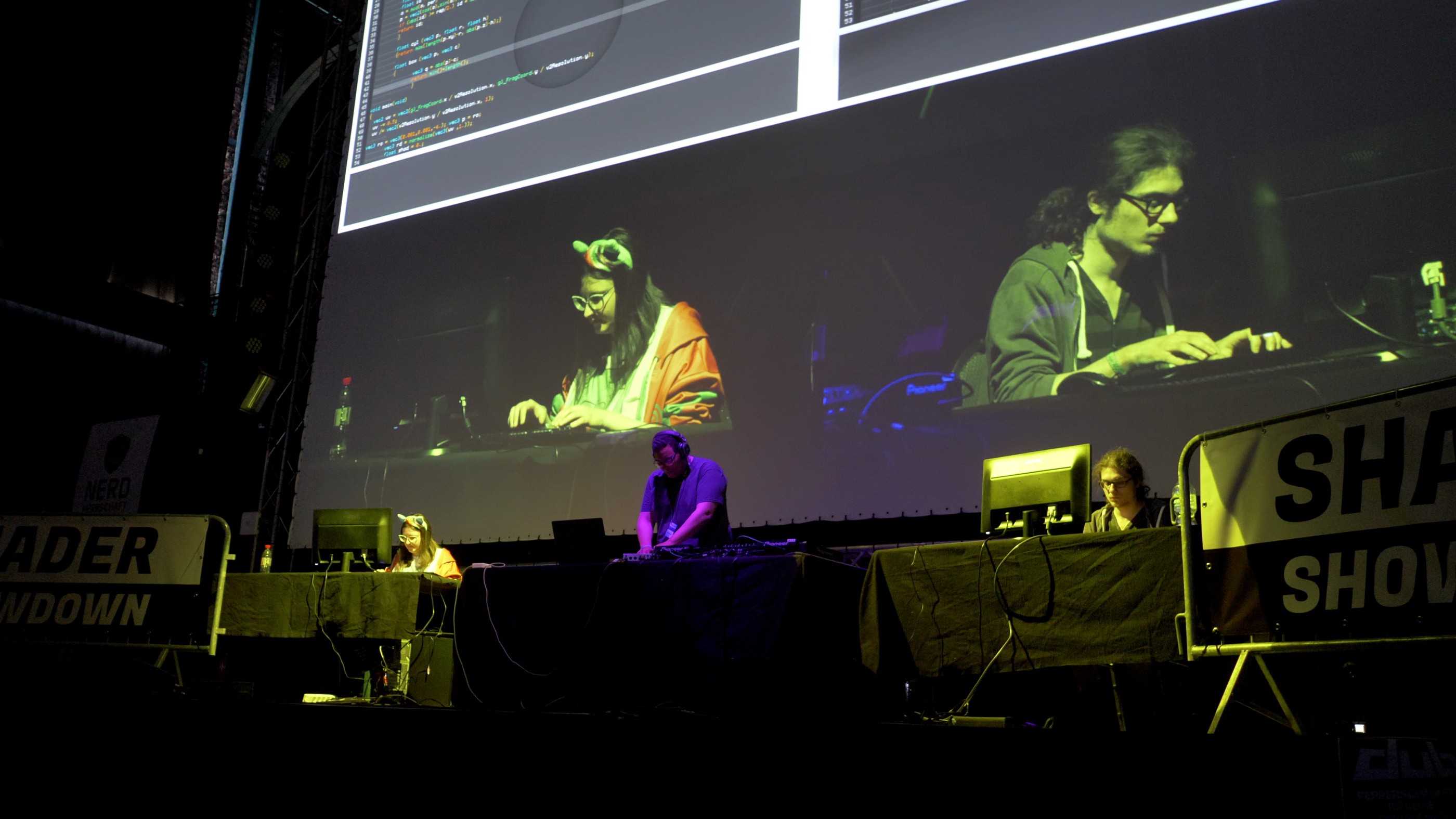Anna-Lina Helsen

Have you met the Demoscene, yet?
From the early days of a ground-breaking digital movement to contemporary and future computer art, emerging from the hacker and cracker scene and a whole bunch of parties
A large hall filled with lights and visual projections, loud music and indistinguishable chatter. A club? Long rows of beer-garden tables with benches and chairs scattered in between, light radiating from countless monitors in the dark. Not a club. No. Instead of dancefloors the focus lies on the audio-visual projections, which are on display. The main screen looming bright over the crowded room.
What is it that is actually shown here? Demos. To newcomers these might look like music videos, however there is much more to it. Demos involve extensive technical know-how and are generated in real-time by executing code, creating audio-visual projections. The focus lies on creating the best works –demos – that are rated by peers. Events like this are called demoparties and are the backbone of the demoscene. The demoscene itself can trace its roots back to the hacker and cracker culture of the 1980’s and is a predominantly European computer community.
The 1980’s home computer revolution made microcomputers easily available, and with it the interest in computer games escalated. As most computer game consumers were teenagers whose financial resources were often limited, swapping of games ensued. Shortly thereafter, game companies placed copy-protection on their games and a competitive sport of removing those protections started among early computer users. Sophisticated programming skills were required to crack these protections. Intros were placed before the start of the actual games, showing which cracker or group broke the copy-protection in order to gain recognition for their work. These intros became successively advanced and over time gained independence from an accompanying game, eventually turning into what are known as demos today. This combination of technical prowess and hacker culture influences formed the roots out of which the demoscene evolved over time. It is also where the high emphasis on meritocracy and the appraisal of peers originated. Based on curiosity, skill-development and an urge to push the boundaries of the seemingly impossible, the demoscene also places a large emphasis on the creation of social togetherness and community.
Over the years the focus of the scene and its parties shifted from so-called copy-parties, where most of the activities were centred around trading and copying games, to demoparties. There one could enter their demo into competitions with others. Demoparties usually take place over a weekend, in the early days at locations such as school halls and auditoriums. However, as the parties grew in size larger venues such as sports arenas needed to be found. Being a largely digital culture, with a lot of the exchange taking place online on websites such as Pouët, demoparties provide a valuable opportunity to meet up in person. Here sceners can talk about the newest developments as well as compete against each other. The created demos are entered in competitions of various categories and are voted for by other demosceners. As technology improved, the possibilities for creating demos became almost limitless. This was a change from the early computer days, where getting the last bit of performance out of limited hardware was a large part of the challenge. Soon different competition categories emerged, placing an emphasis on limitations such as extremely small code size like 256 Bytes or specific computer platforms. New ones are being added as well, such as Shader Showdown, a form of live-coding, or Graphics enticing newcomers interested in working with diverse digital media to join in the demoscene.
In summary, the demoscene is a complex digitally focussed culture, creating astounding works of art and programming. Numerous ground-breaking developments which have taken place within this scene have found their way into computer games and other areas of digital art. The Demoscene – The Art of Coding (AoC) initiative, works towards recognizing the scene as a UNESCO intangible world cultural heritage. Applications in Finland and Germany have already been successful, with the goal of having the demoscene be recognized as a transnational cultural heritage in the future. The best way to discover this scene is attending a party in-person, as nothing beats the experience of seeing the mesmerizing audio-visual productions on a large screen with the volume turned all the way up and the ground vibrating in rhythm to the demo.
Bio
Anna-Lina Helsen ist Kunstwissenschaftlerin mit Schwerpunkt Medienkunst- und Technikgeschichte. Ihre Forschung im Bereich der Computerkunst über die sogenannte Demoszene hilft diesem Forschungsgegenstand in der öffentlichen Wahrnehmung eine gesteigerte Aufmerksamkeit zu erlangen.